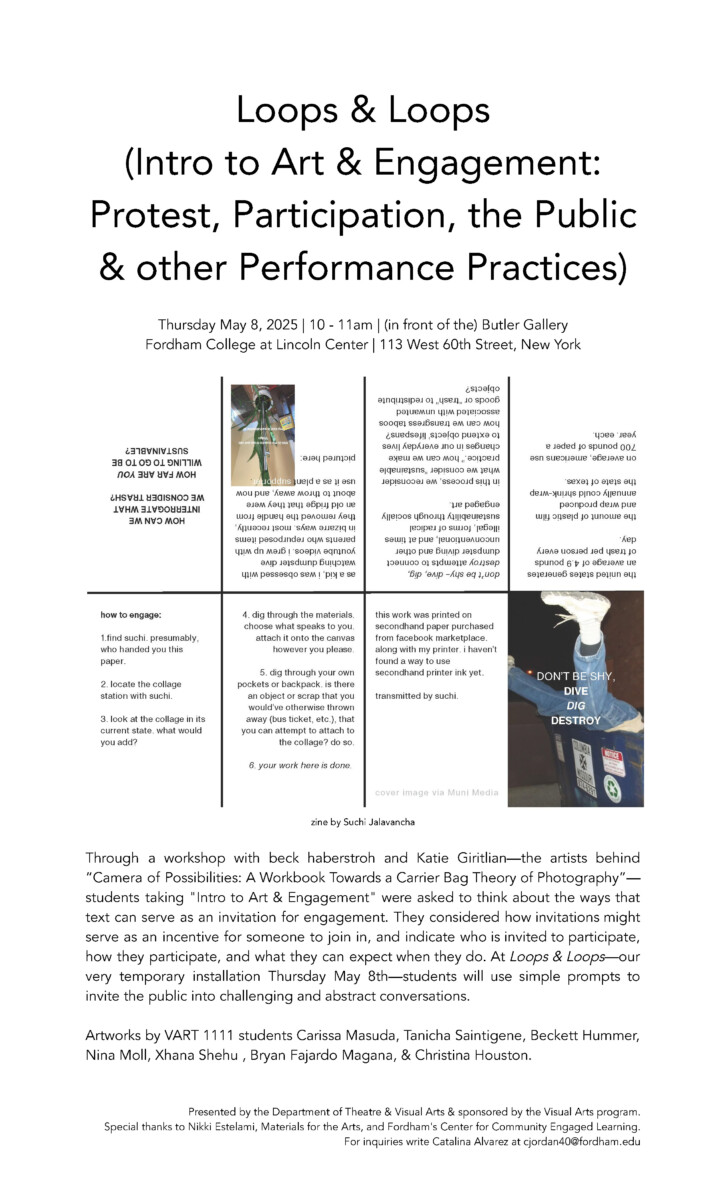


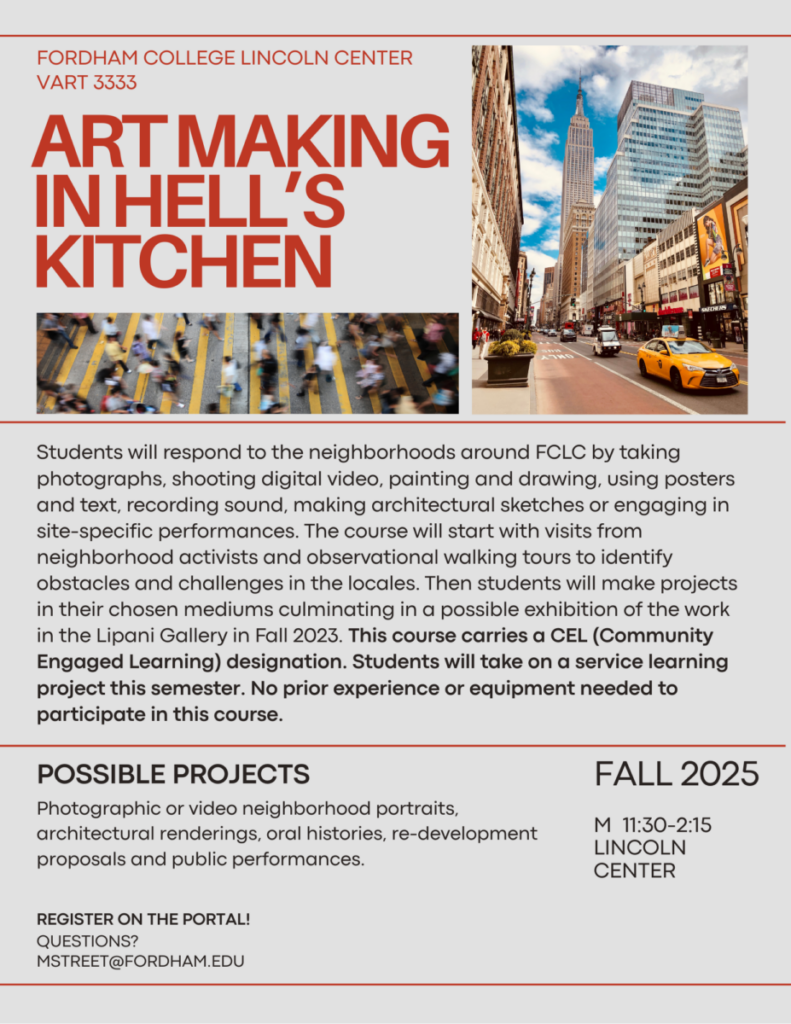

Tony Nominated Broadway producer, entrepreneur, writer, director, and performer, Marjuan Canady (FCLC ’08), returned to campus on April 1st to discuss with “Arts, Social Justice, & Human Rights” students (taught by Fadi Skeiker) concepts in applied theater and the importance of forging one’s own path when navigating a career in the arts.
After graduating from Fordham with a degree in theatre and African and African American studies, Canady continued her studies at NYU Tisch which led to the production of her one-woman play “Girls! Girl? Girls.” Using this experience as a framework, Canady explained to students how they might use a grassroots approach to theater and production, and how to use theater to engage with topics that are meaningful to them. Canady also challenged students to consider the use of satire when tackling larger, societal issues. She presented them with several approaches to satire and explained the concepts using examples from her own production of “Girls! Girls? Girls.” to show how these techniques could be applied in their own work.
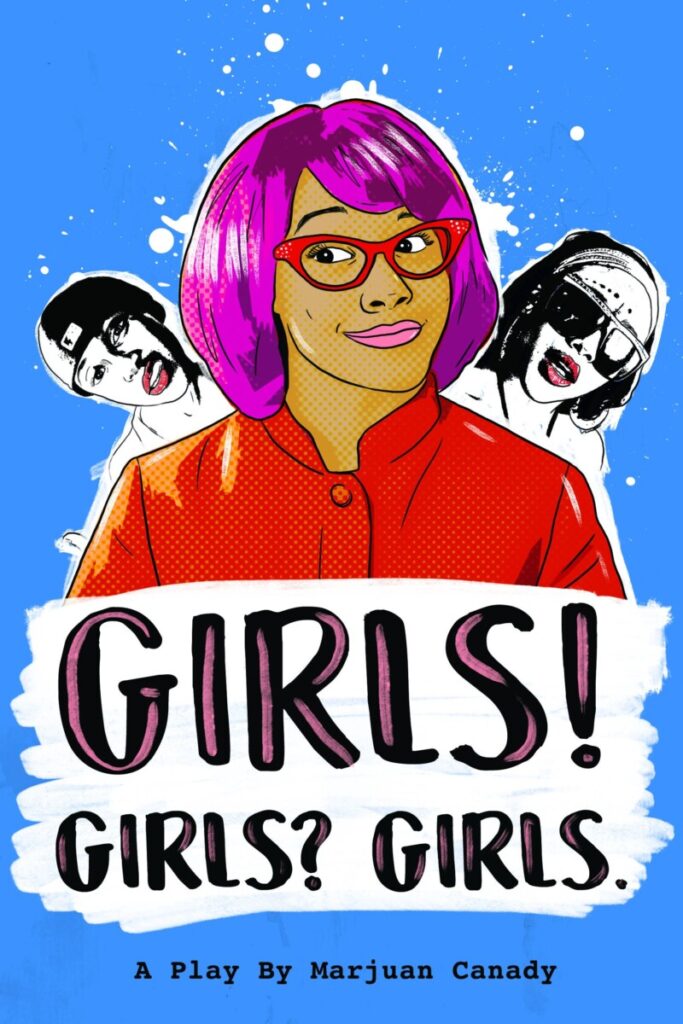
During this workshop, students were tasked with a solo theater exercise, in which they were instucted to identify an issue that they are passionate about and then create a monologue or scene using satire. Students explored three techniques of satire – exagerration, reversal, and parody – and were instructed to encorporate two of them into their monologue or scene. Through this exercise students where able to apprciate the power of satire and comedy when addressing potentially serious issues. By creating room for humor in the discussion, satire allows audiences to step back and address the “ridiculousness” of current societal issues. Through Canady’s teachings, students learned how to use applied theater to take deep issues that are often difficult to discuss, and to create a natural and intimate dialogue around these issues through performance.
This week, the “Arts and Social Justice” class, taught by Fadi Skeiker, had the joy of welcoming eight incredible high school students from the NYCHA Amsterdam Houses Tenants Association in NYC. Together, students explored what it means to build, defend, and reimagine community through theatre.
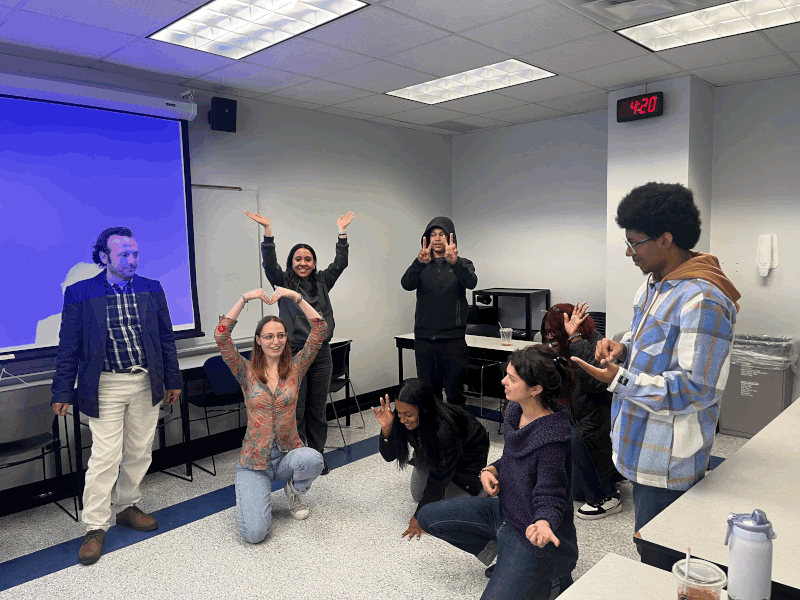
In one of the central exercises, students were divided into two groups—each tasked with inventing a new island. One group imagined a naturalistic island, rooted in organic life and balance. The other built a technological island, wired and future-facing. They created chants, embodied their landscapes, and made frozen images that told the story of their worlds.
Then came the twist: an earthquake strikes, and one island must seek refuge on the other.
What followed was a powerful negotiation: Who gets to leave? Who gets to stay? What makes a place worth defending—and what makes it worth sharing?
Students debated migration, safety, resources, and identity with clarity and heart.
One student shared the insight: “It’s hard to ask for help when you’ve been made to feel less than.”
This class focused on presence rather than performance, and was about using theatre as a space to listen, imagine, and witness one another. This exercise served as a reminder that justice work starts in rooms like this—with questions, collaboration, and care.
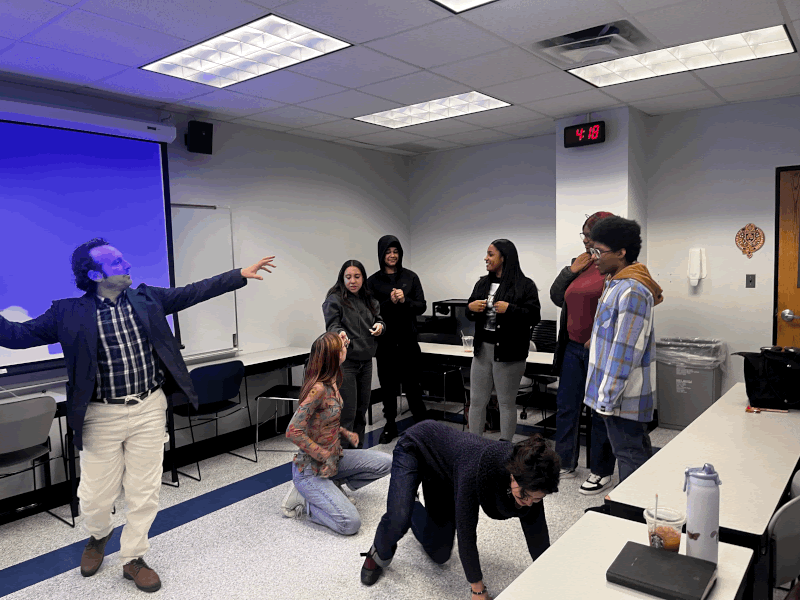
This visit was supported by Center for Community Engaged Learning (CCEL) at Fordham University.
FCLC, McNally Amphitheatre | 140 W 62nd St, New York, NY 10023
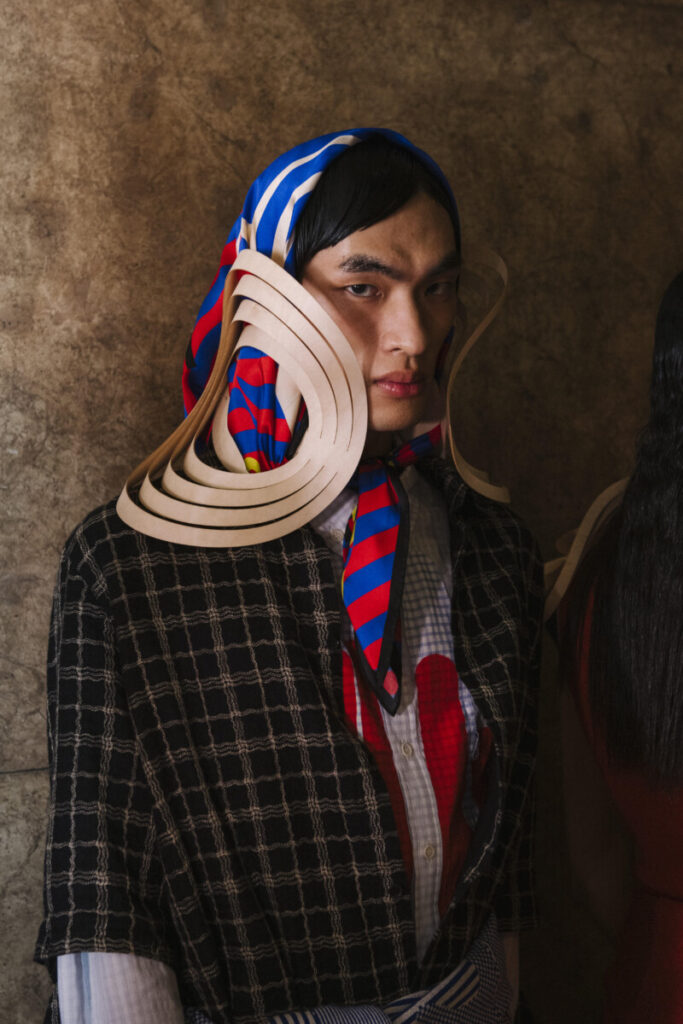
Join us for an evening of conversation about fashion and sustainability with renowned designers Henrik Visbskov (Denmark) and Brunela Ramirez (Peru). Our guests will discuss their design philosophies & how to create a collection from idea to fabrication. Original designs and garments to be showcased!
Co-sponsored by A&S Dean’s Challenge Grant, Professor Connection Program, Center for Community Engaged Learning, Fashion Studies, Art & Engagement at the Visual Arts Program and Gabelli School of Business. Organized by Fashion Studies Program Director Robb Hernández & Fashion Studies Executive Board members Alexandra M. Thomas & Catalina Alvarez.
This event is presented in conjunction with Henrik Vibskov’s The Bank is Dead
Learn more about each designer:
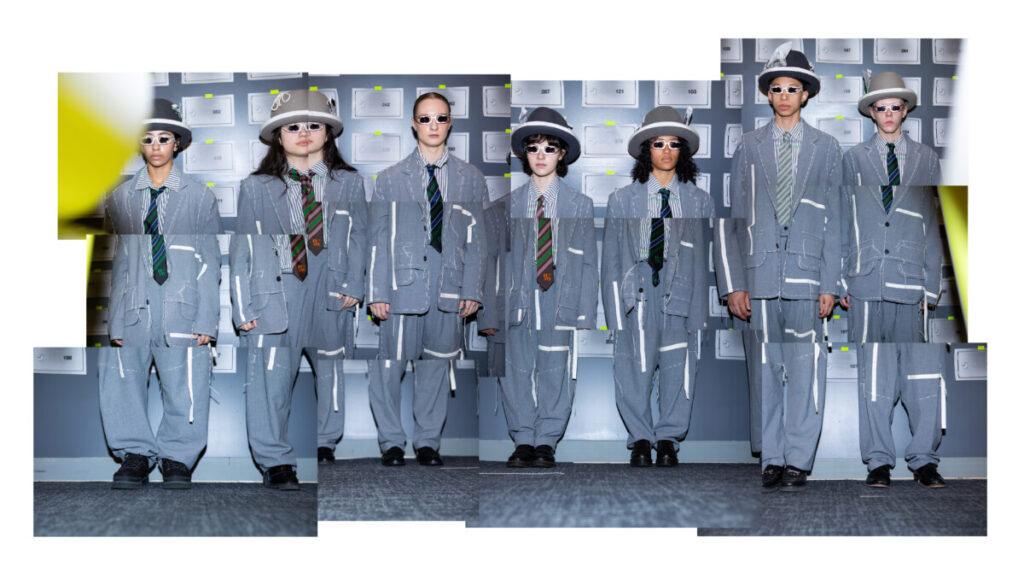
Featuring Fordham University students Kasey Orava, Reese Windust, Claire Galloway, Rylan K. Carrol, Luke Tressler, Kimberly Whitehall, Dylan Zavier Peralta & Jake Metcalf.
All photos by Victor Jeffreys II
Once a space of wealth and restriction, this former bank in Brooklyn New York was transformed into a soft, surreal stage. Inflatable structures pressed against the architecture, between floor and ceiling, like swollen memories of security, like the last breath of the institution trying to hold its place in a world that’s moved on.
The printed bank boxes hinted at past obsessions with protection and power. They fluttered, flew off with the slightest breeze, turning the walls into living symbols of financial volatility.

Dancers, dressed as bankers, performed a 10-minute ritual at regular intervals— echoing, mocking, and ultimately shedding the gestures of the financial world : Their gestures mimiced the mechanical rituals of old finance: stamping papers, tightening ties, shaking invisible deal hands. But gradually, their movements loosened, their rhythm broke, the suits become costumes rather than uniforms. A farewell to a broken system. A welcoming of creative chaos.
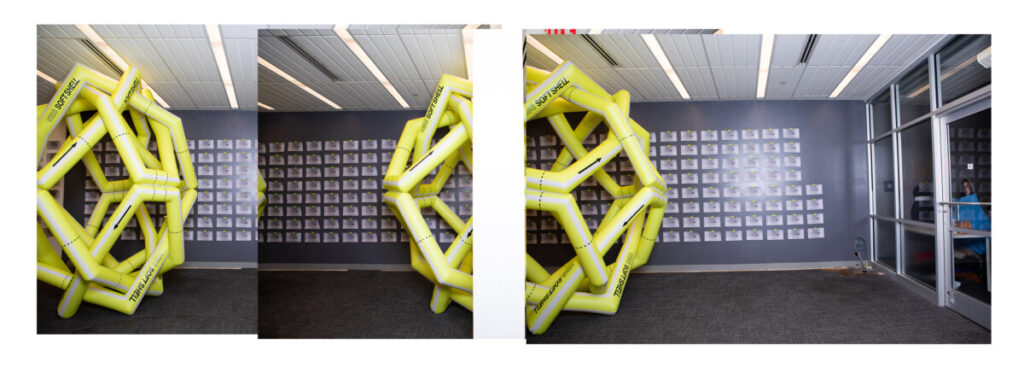
All visitors received a key to the bank box when they arrived at The Bank.
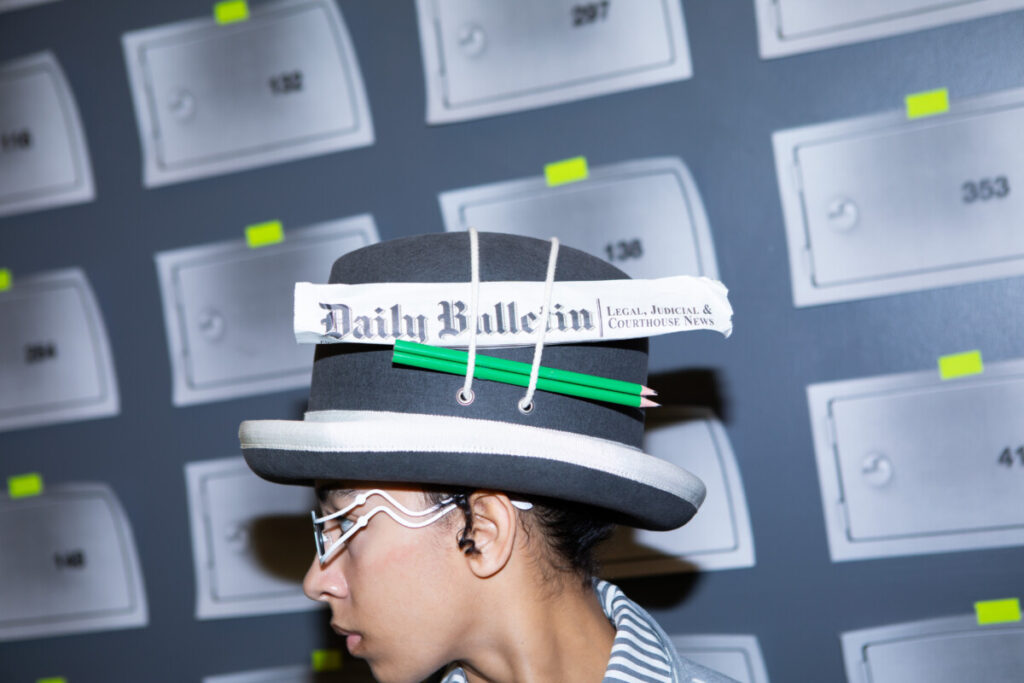
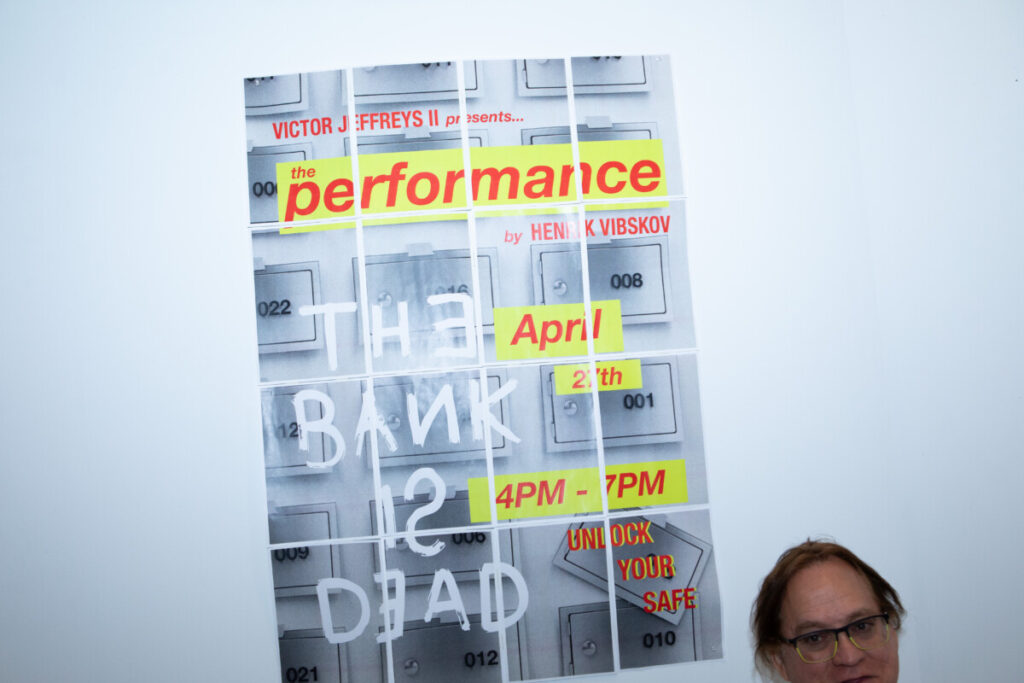
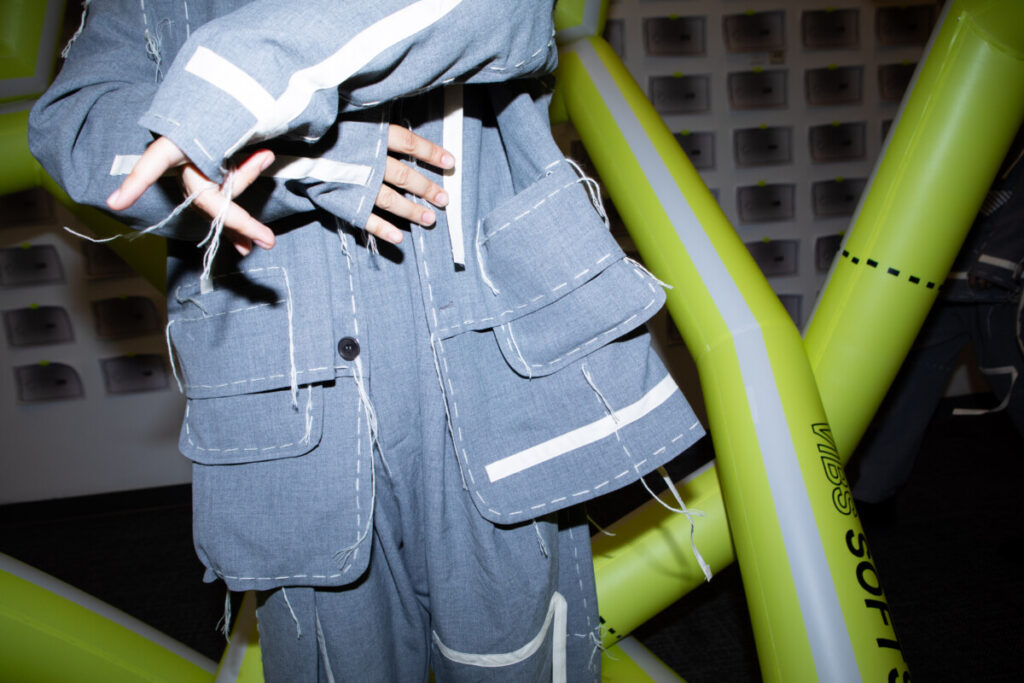
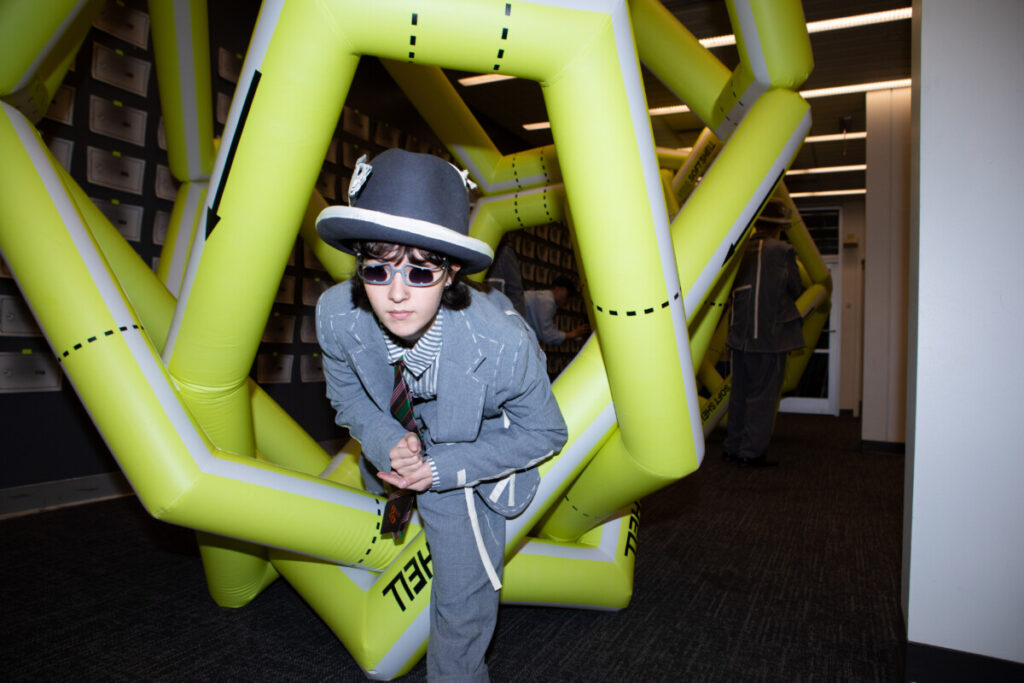
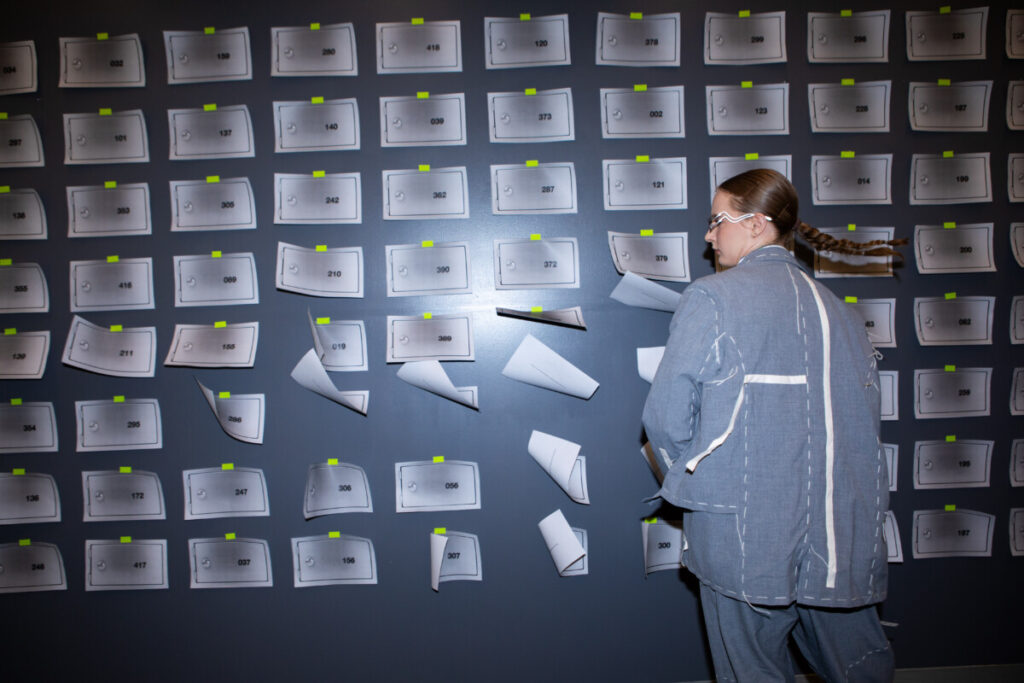
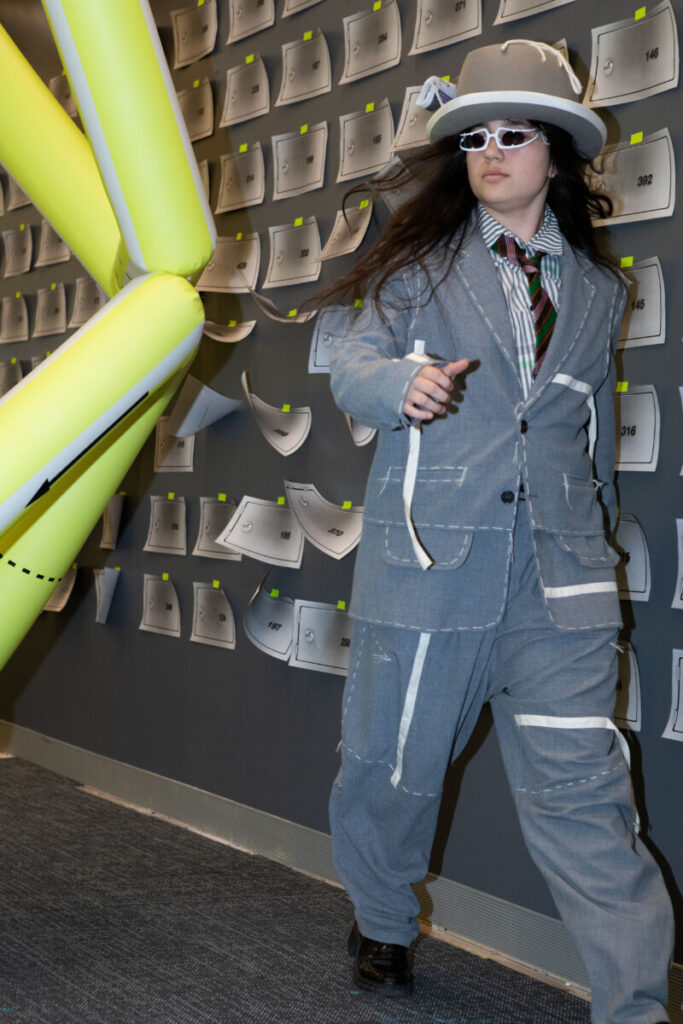
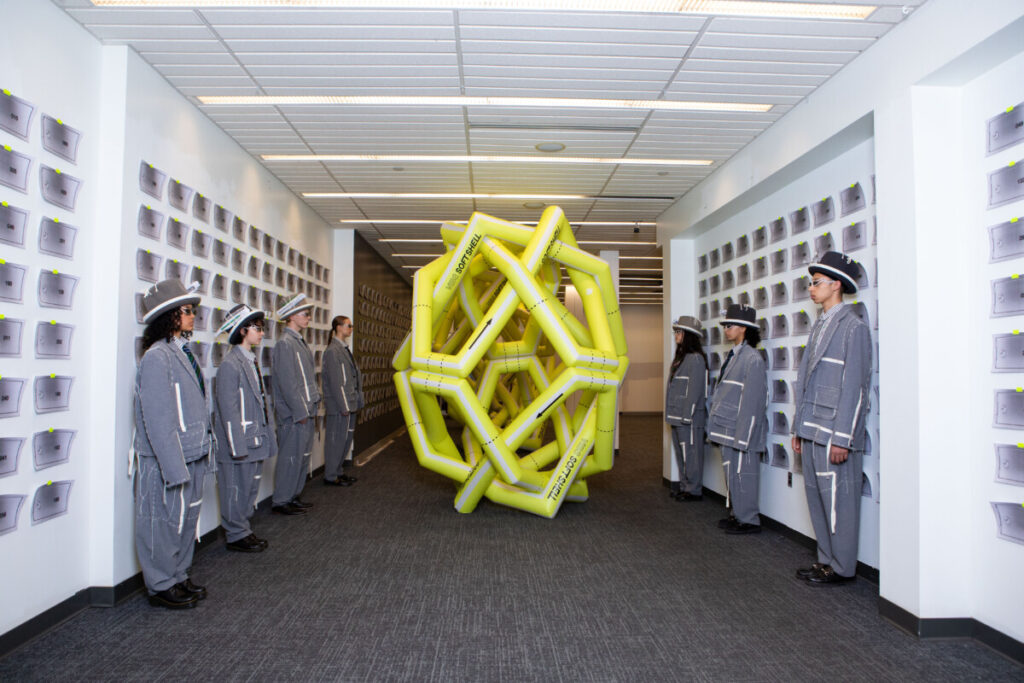
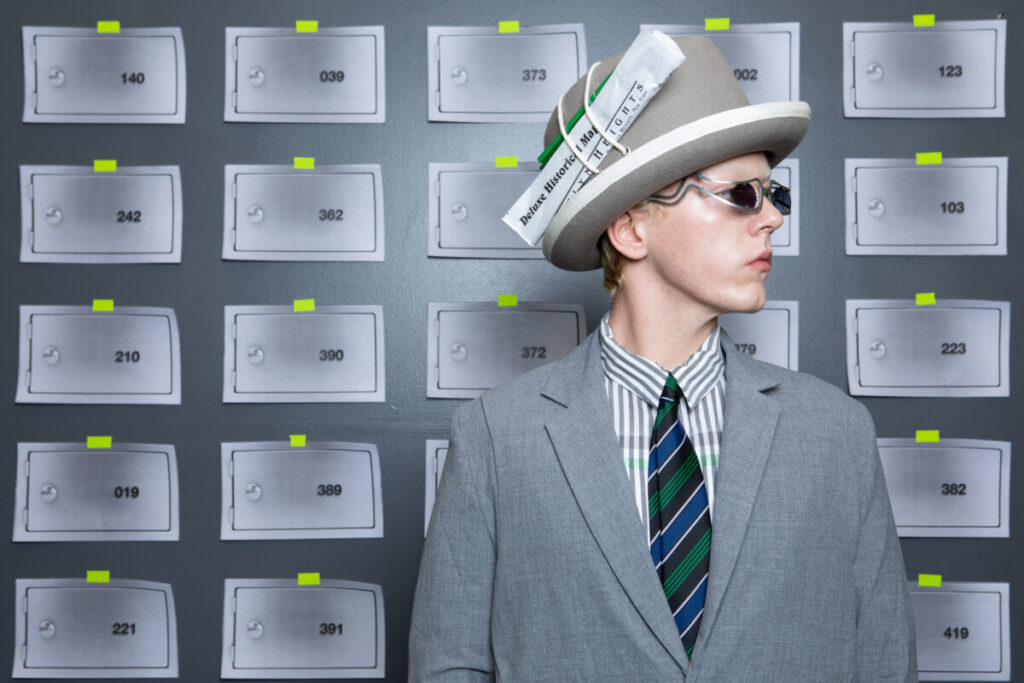
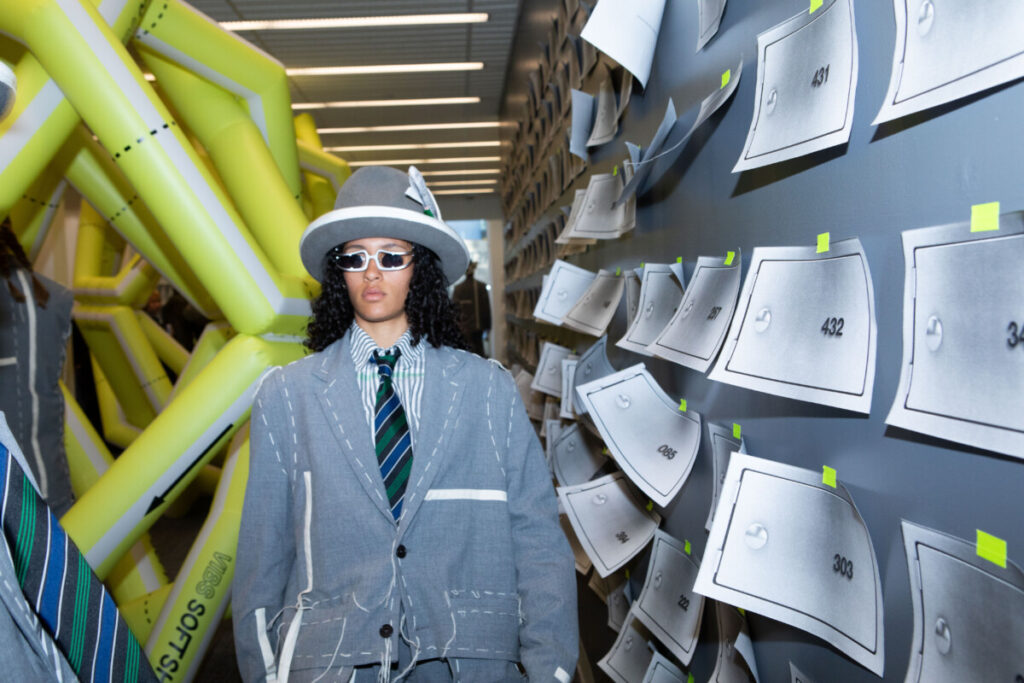
Fordham University – Henrik Vibskov- The Bank Is Dead – Victor Jeffreys II – mode PR
Presented in partnership with Fordham’s Art & Engagement & Fashion Studies programs and the Center for Community Engaged Learning. Fordham partnership organized by Catalina Alvarez, in conjunction with April 29th event “Iridescent Worlds“.
Who is Henrik Vibskov?
Henrik Vibskov is a renowned and award-winning Danish fashion designer, artist, curator and musician.
Although commonly associated with fashion and the twisted yet tantalising universes created around each collection, Henrik’s creative practice covers multiple platforms.
Working in the intersection between art and design, his work ranges from fashion collections to installation, performances and exhibitions, always exploring creativity without limits and adapting the design approach to the changing contexts.
Since his graduation from Central St Martin’s in 2001, he has produced more than 40 fashion collections and exhibited in several international design fairs, festivals and museums all over the world, including MoMA in New York, Palais de Tokyo in Paris, The 21st Century Museum of Contemporary Art in Kanazawa and the ICA in London, to name a few.
Next to the biannual fashion collections, he has also designed costumes for numerous operas and performances, including collaborations with Hotel Pro Forma, the Oslo Opera House, The Swedish National Ballet and the Brussels Opera House.
Most recently he designed the costumes for the ballet “Hammer” by Alexander Ekman at the Gothenburg Opera in Sweden.
As a musician, Henrik keeps himself occupied as a drummer currently with his band Luksus, who are to perform at Syd For Solen Festival 2023 in Copenhagen. He has also played with Hess is More, his own project Mountain Yorokobu, Mikael Simpson and Trentemøller, who he toured the world with for 6 years.
Arts, Social Justice, and Human Rights: Foundations (THEA 4050) is a course that explores the relationship between arts and politics, and arts and community organizations. Taught by Professor Fadi Skeiker, students are encouraged to consider the transformative potential of “Theatre of the Oppressed” and applied theatre in empowering marginalized communities. This semester, students are working on a cumulative project, Two Islands, a play that explores themes of division, cultural identity, and reconciliation.
On March 25th, students in this class had the incredible opportunity to work with Jarrett Key, an artist whose unique background in both fine art and performance brought a fresh and important perspective to their creative process. Known for their powerful work in sculpture, painting, and performance, Key guided the students through a series of devised theater exercises that allowed them to break out of their comfort zones and consider new framework for their class project.
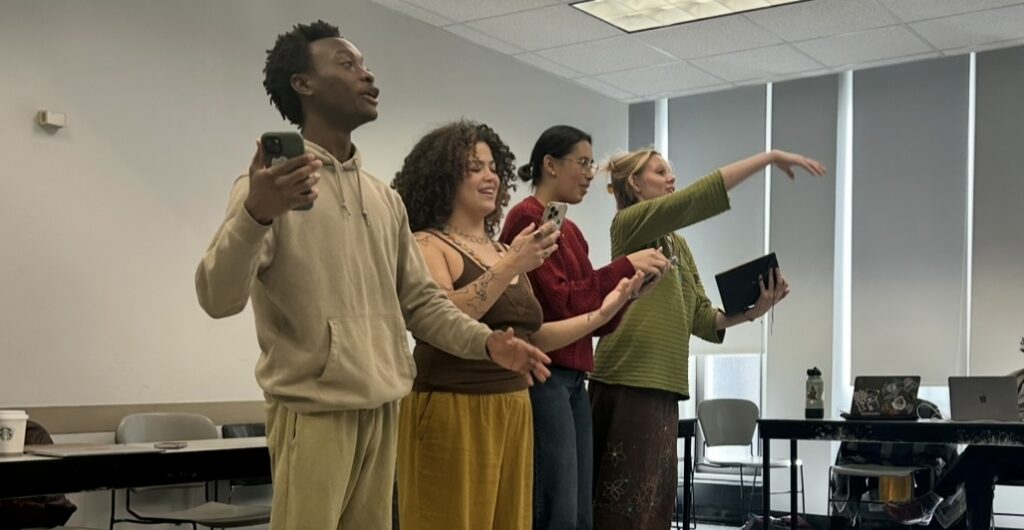
Jarrett Key (b. 1990, Seale, AL) is a multidisciplinary artist who lives and works in Brooklyn, NY. Growing up in rural Alabama, Key’s practice draws deeply from their upbringing and the oral histories of the South, while also embracing contemporary modes of expression. After graduating from Brown University in 2013, Key pursued their fine art practice in New York City, later earning an MFA in painting from the Rhode Island School of Design in 2020.
Key’s work integrates sculpture, painting, and performance to create objects that embody multiple forms within one frame. The artist’s exploration of the intersections between history, memory, and contemporary issues is evident in their work, which often addresses the lost stories and historical conditions that shape their life. Their work has been featured in major exhibitions, including their first solo show, From the Ground, Up at 1969 Gallery in 2022, and their recent 40ft mural commission for HMTX Industries in 2023.
The workshop began with a presentation by Key, who introduced the students to iconic examples of land art and performance art, such as Richard Long’s “A Line Made By Walking” and Antti Laitinen’s “It’s My Island”. These examples sparked new ideas in the students’ minds, encouraging them to think about how their bodies and the environments around them could serve as effectual tools in creating their own theatrical work. Key’s ability to draw connections between land art, performance, and their own practice gave the students a new perspective on how they could use their bodies and the spaces they inhabit in unforeseen and dynamic ways.
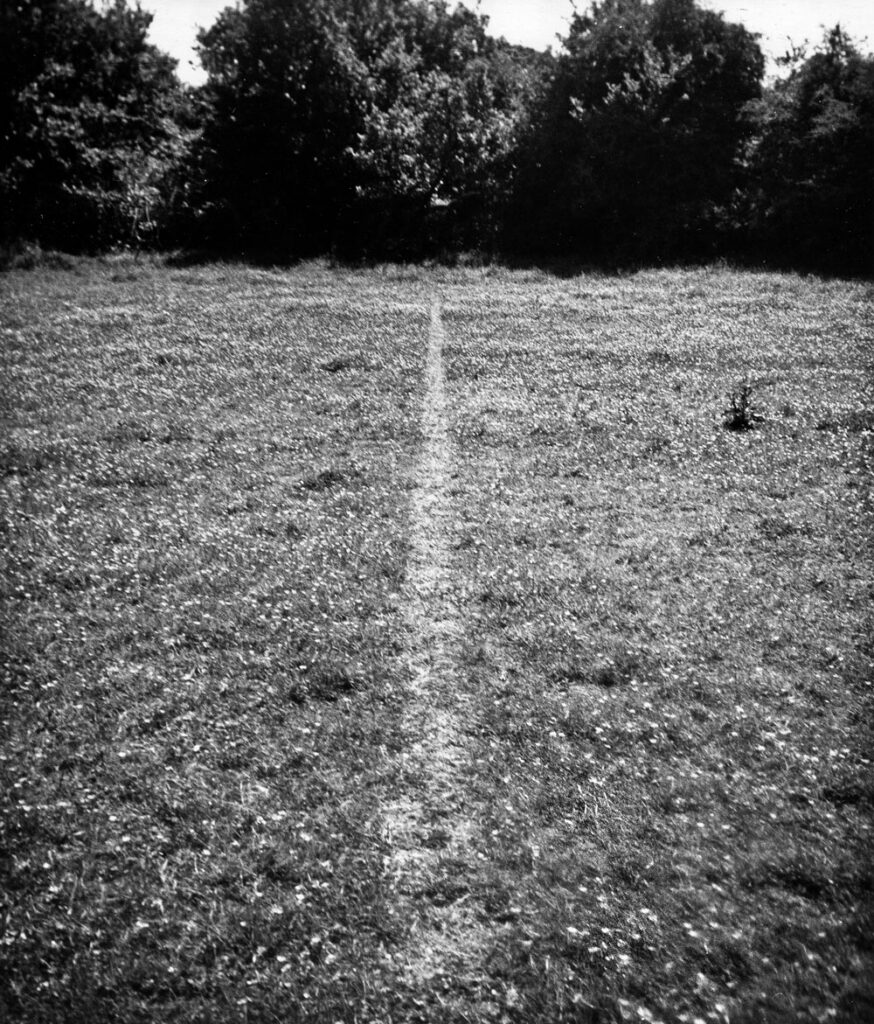
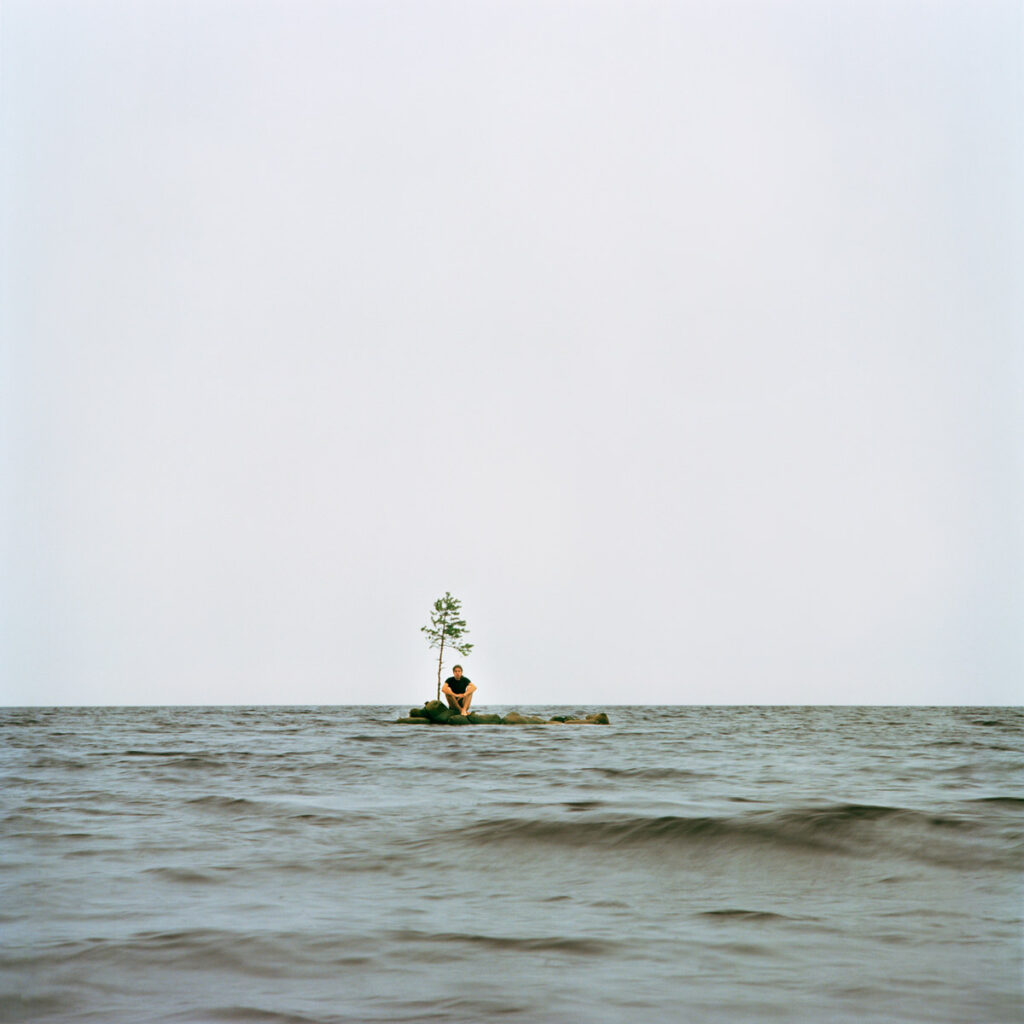
Devised theater, which emphasizes collaboration and collective creation, was the perfect framework for Key’s exercises. The students were encouraged to think beyond traditional scripts and explore how physical movement, space, and sound could work together to tell a story. Key led the students through several interactive exercises that encouraged them to tap into their creativity and push the boundaries of their performance. This included a “Song + Dance” Excercise where students were asked to create spontaneous movements and sounds alongside with lyrics they had previously created for Two Islands.
Students also participated in an exercise called “Walking on the Grid” where they walked along a imaginary grid while experimenting with movement, timing, and space. This exercise mirrored the practices of previously discussed land and performance artists, allowing students to explore how their bodies could interact with physical spaces in new and intentional ways. This exercise challenged students to think about how structure and freedom can coexist in performance, and how they might incorporate this into their play.
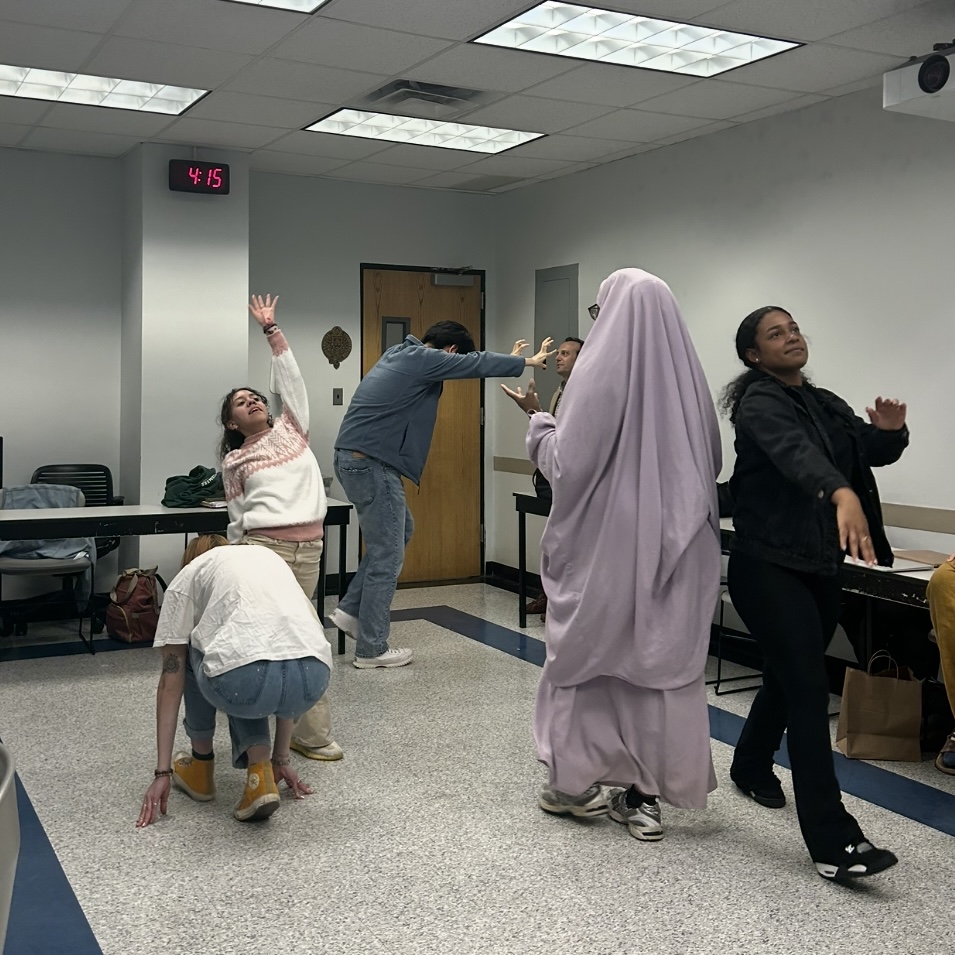
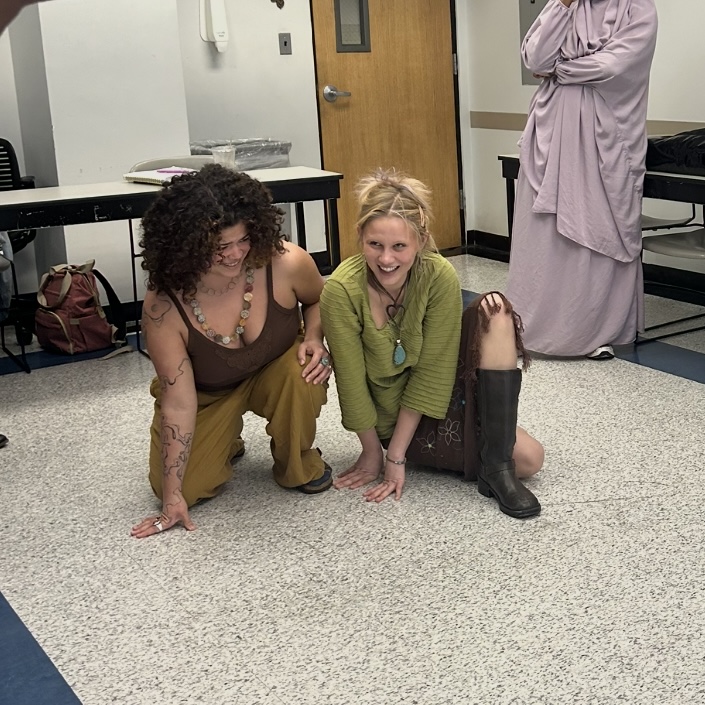
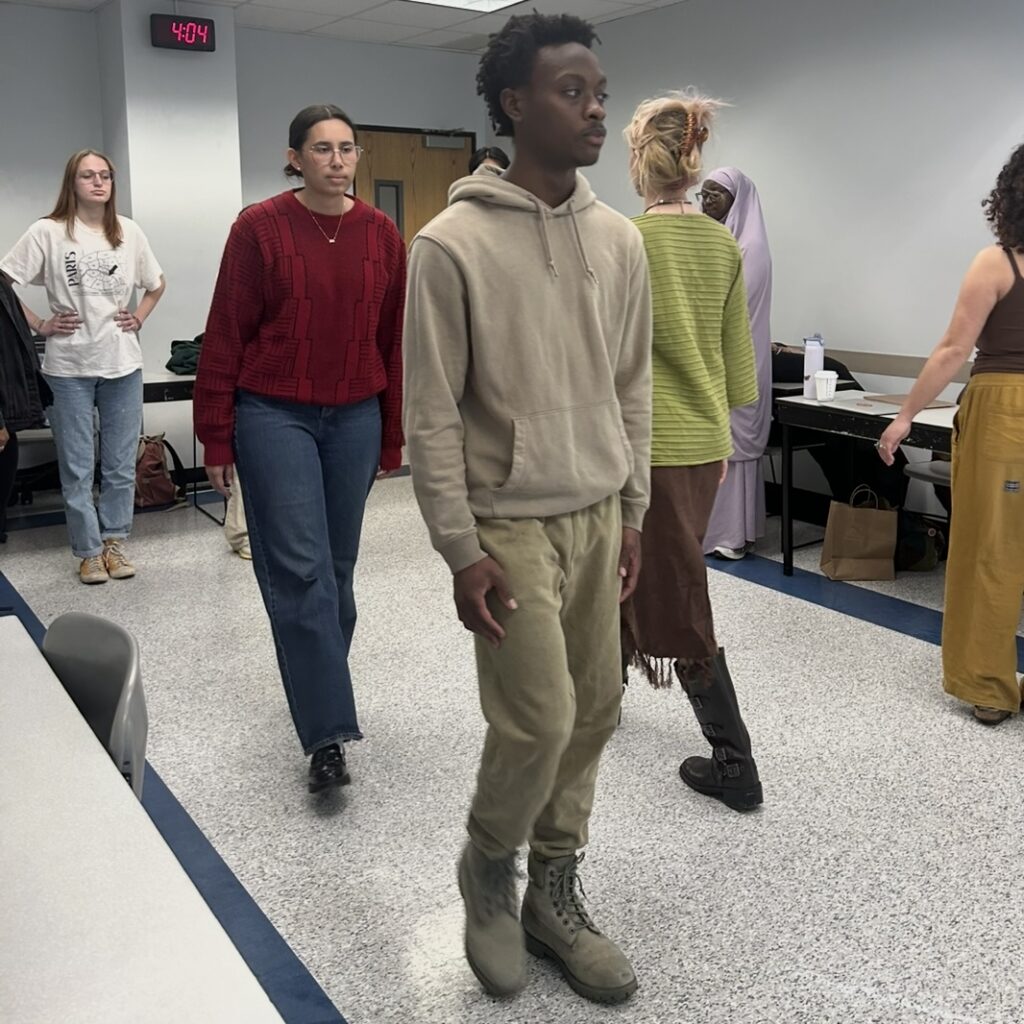
Thursday April 3, 2:30-5pm | Campbell Multipurpose Room, Rose Hill Campus
Limited number of free registrations here: https://forms.gle/DRsCapPNea5f22gVA
Kalamkari is a 3,000-year-old textile craft that originated as a medium of storytelling using a bamboo pen and natural dyes. This traditional art form involves at least 23 individual stages and is currently practiced only in Sri Kalahasti, India.
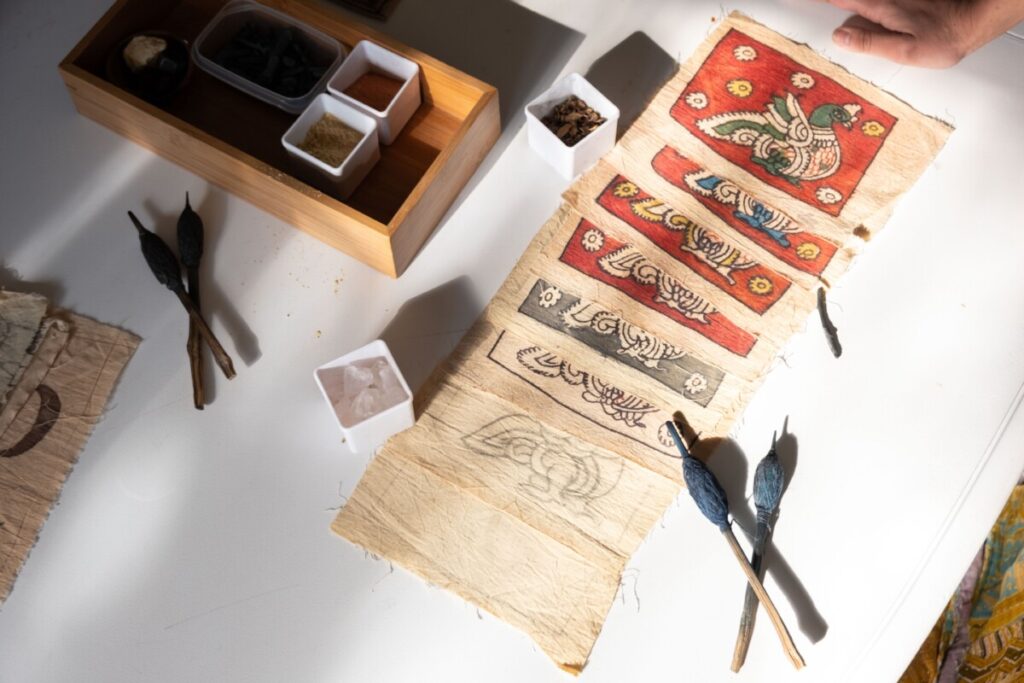
This workshop given by Fashion Designer Nikita Shah consists of a live demonstration and a simultaneous critical discussion of its history. Participants learn to create a simple piece of kalamkari.

WORKSHOP STRUCTURE:
Brief presentation on history of Kalamkari (30-40 mins)
Demonstration & creation of kalamkari piece (1-2 hours)

Website with more info: https://www.un-title.com/workshops
This workshop is co-presented by Fashion Studies, Art & Engagement and the Center for Community Engaged Learning. Organized by Catalina Alvarez.
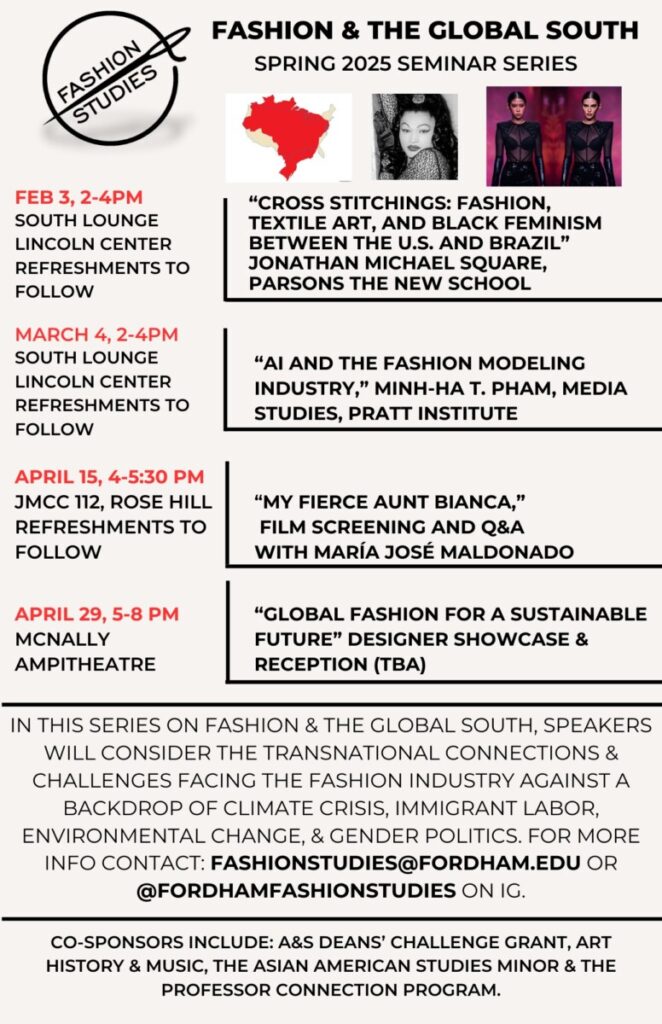
The Fall 2024 semester of “Art and Action on the Bronx River” at Fordham culminated in an array of 12 individual student projects ranging from a mini-documentary, to a dance piece, to a 24-mile walk, as well as a number of other artworks. Taught by Professor Matthew López-Jensen, the course explores the intersection of art, ecology, and history, specifically focusing on the Bronx River and the communities surrounding it. For their final projects, students were tasked with creating ambitious works that responded to the river in creative and thought-provoking ways.
Emerging artist Tori Garcillano has taken to the Bronx River to create a statement piece that implores viewers to consider the ways in which the art of dance can allow people to honor their bodies and surroundings. Her question is as follows: dance does not only exist in studios or on stages but in the very way that we interact with the world around us.
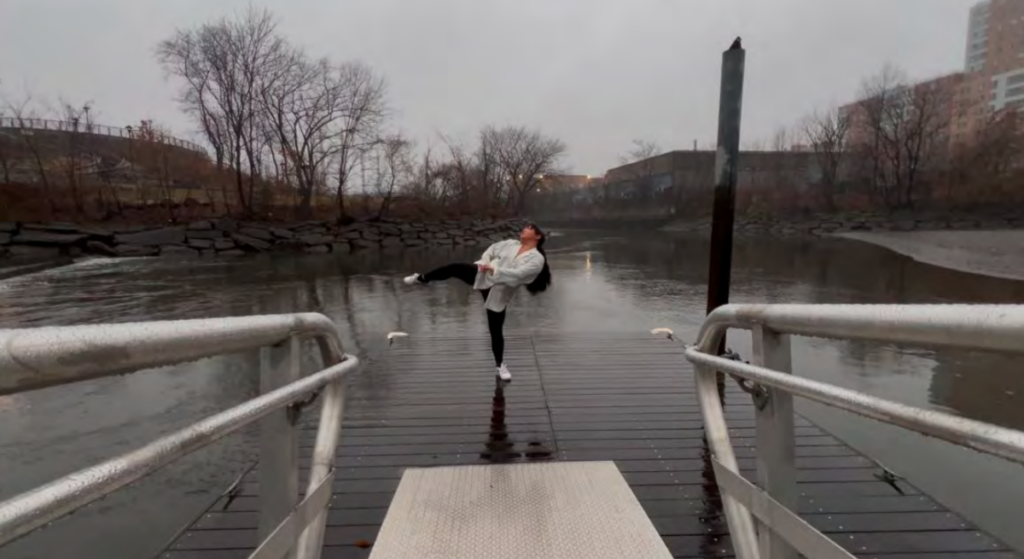
In this video piece, Garcillano dances her choreography on a dock atop the Bronx River at Starlight Park, directly across the way from the Bronx River House. In between moments of choreography, she has added brief clips of sights from the riverbank, focused mostly on the movement of the water. Just as water
creates reflections, Garcillano views her movement as a reflection on the ways in which dance is an expansive art form that exists beyond the body itself.
Link to piece: https://youtu.be/i2AWfbS59aM
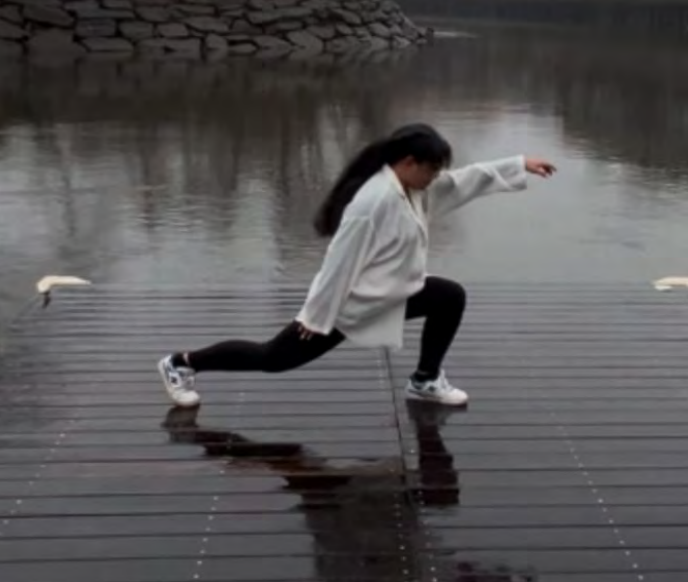
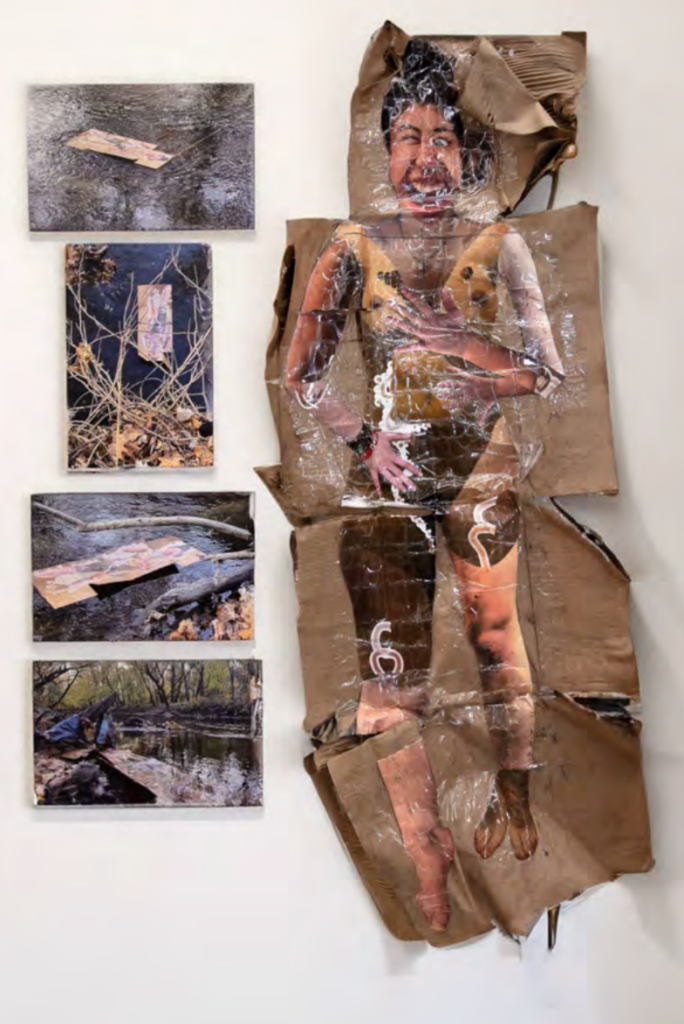
When asked to describe her piece, collage artist Julia Mancini said it all began with a question- “Can take your picture?” From here, she collected body parts: a foot from a friend, her sister’s leg, and her own two hands. Her goal was to create a physical creature, a conglomeration of the people in her life, to bring to the river. “I wanted to exaggerate the inaccessibility of reaching the river and construct a reality where I could bring all of these people there, a reality where they could even swim in it.” She sought to create a symbolic creature with Photoshop to be blown up, printed, and then secured to an outstretched cardboard box and sealed with clear packing tape.
Patrick Dolan embarked on a 9-hour trek spanning the entire 24-mile length of the Bronx River. His journey took him from the busy metropolis to the small forests of our city, capturing the diverse ecosystems that exist within the city’s veins.
The journey began at Kensico Dam in Valhalla, NY, and ended Soundview Park, where the Bronx River meets the East River, with the goal of trying to stay as close to the river as possible during the journey. The Bronx River, once a vital waterway, now flows through a landscape transformed
by urbanization, offering a unique perspective on the intersection of nature and human development.
Link to project: https://www.behance.net/gallery/215144205/From-Start-to-Finish-River-Walk
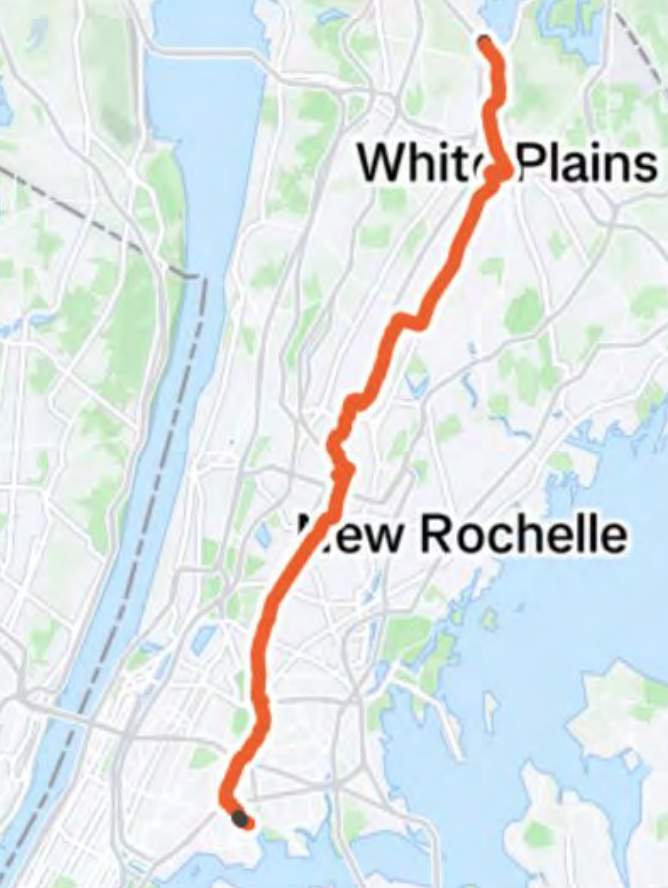
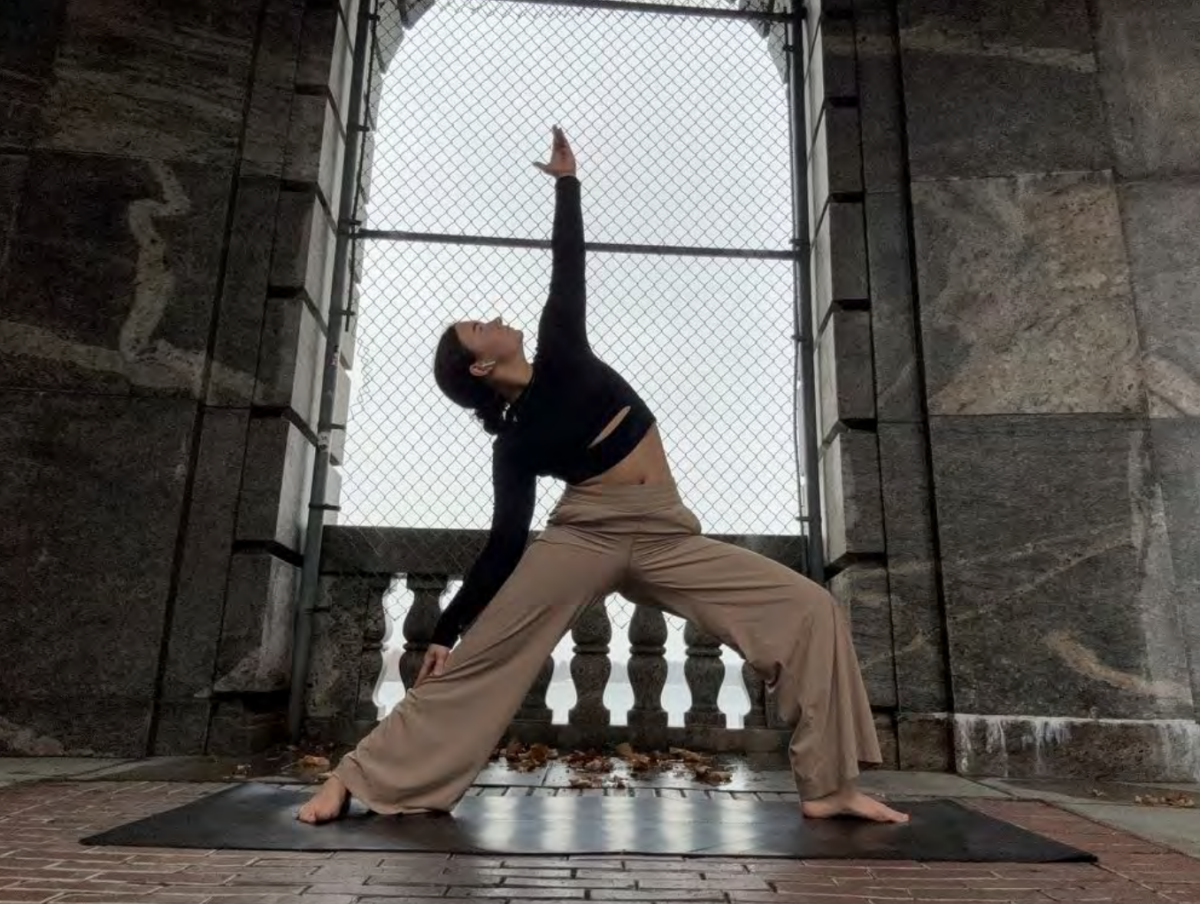
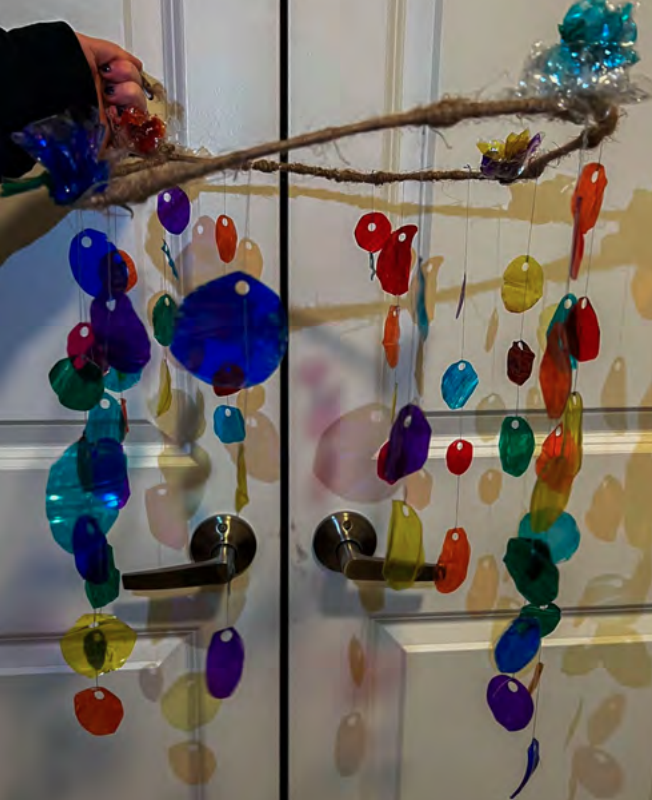

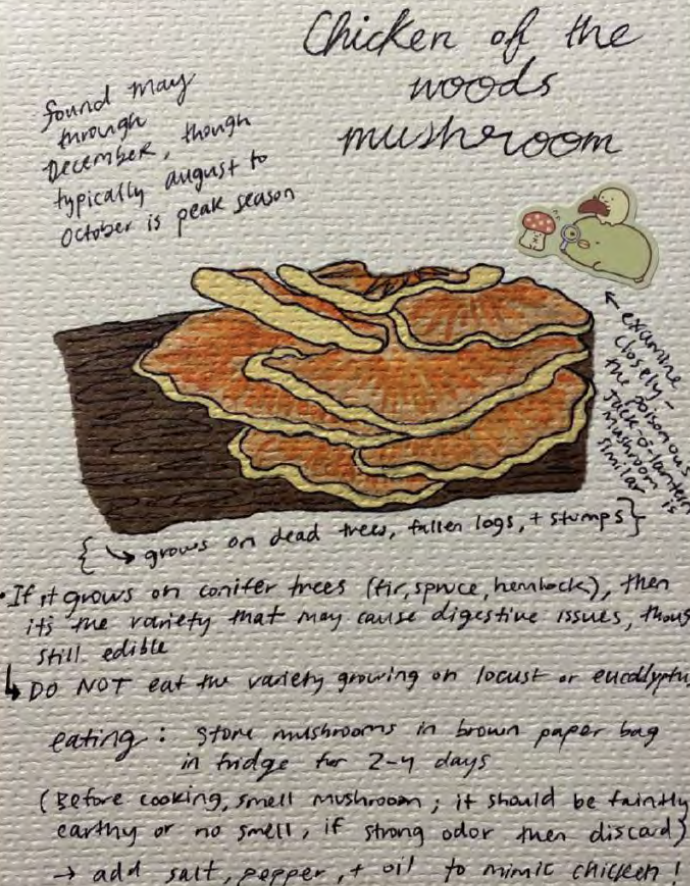
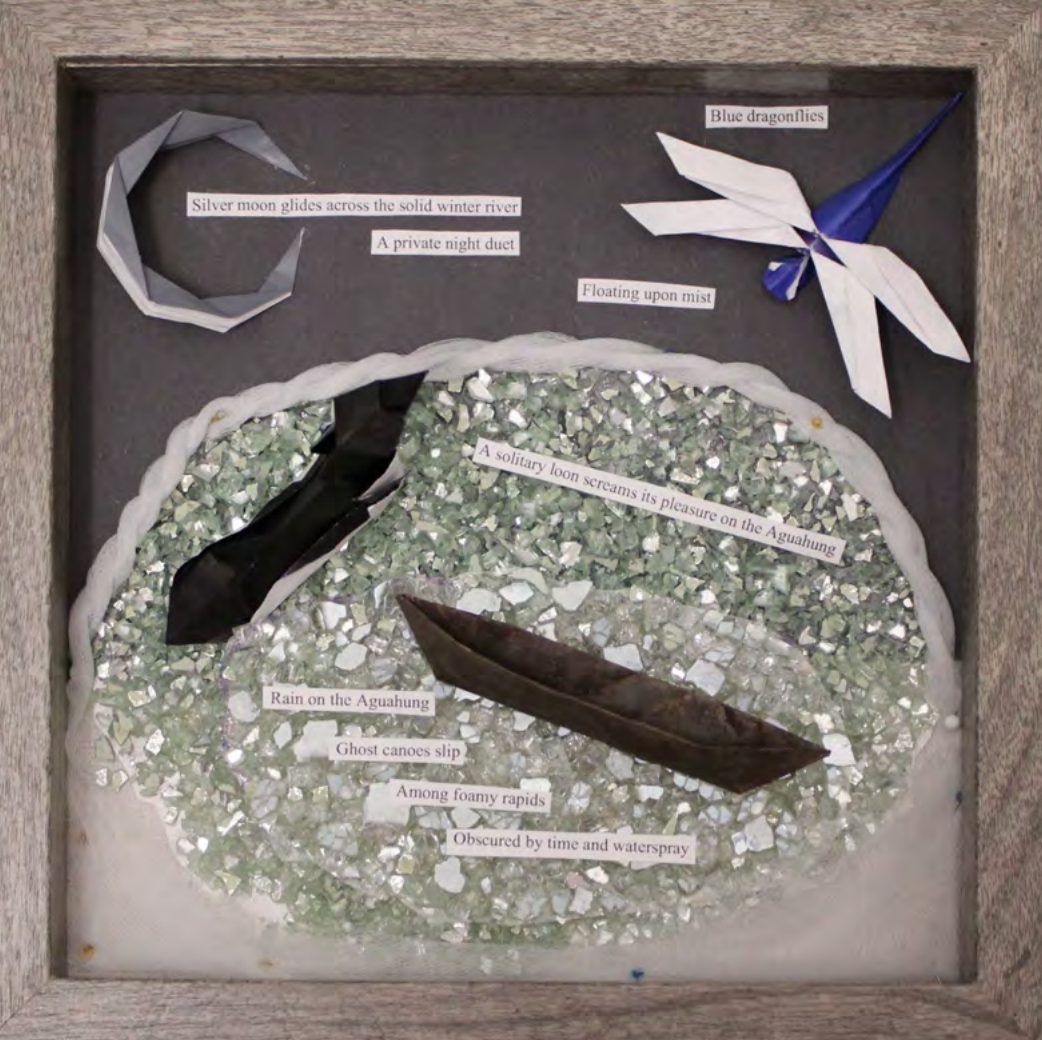
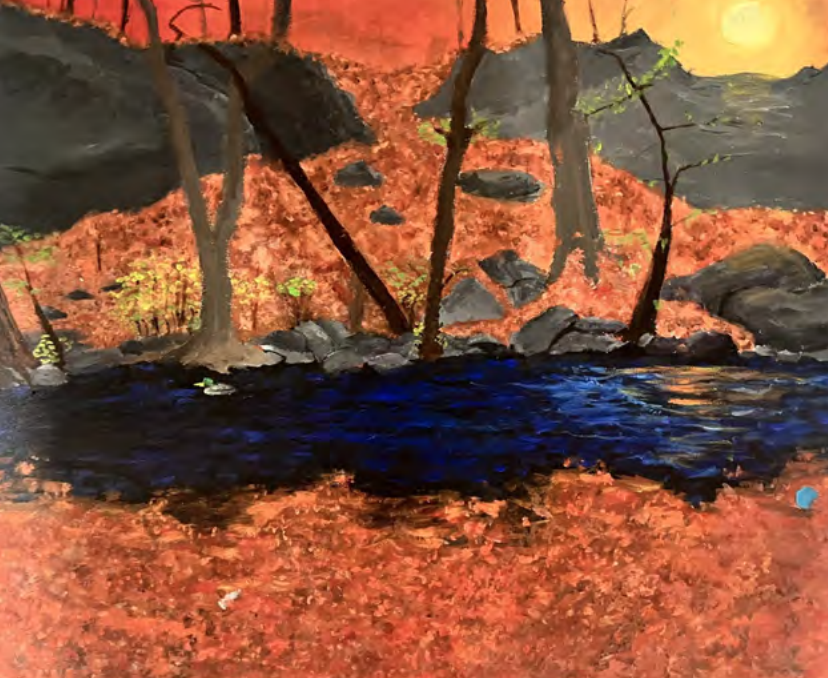

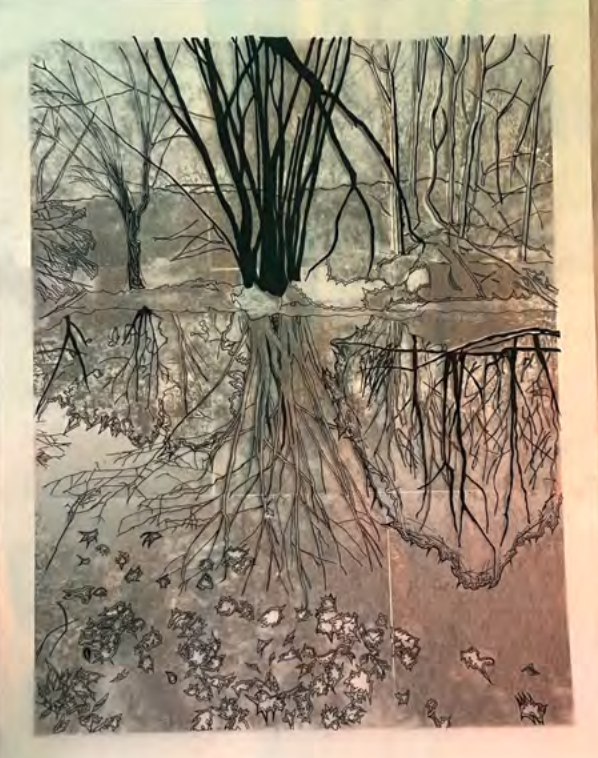
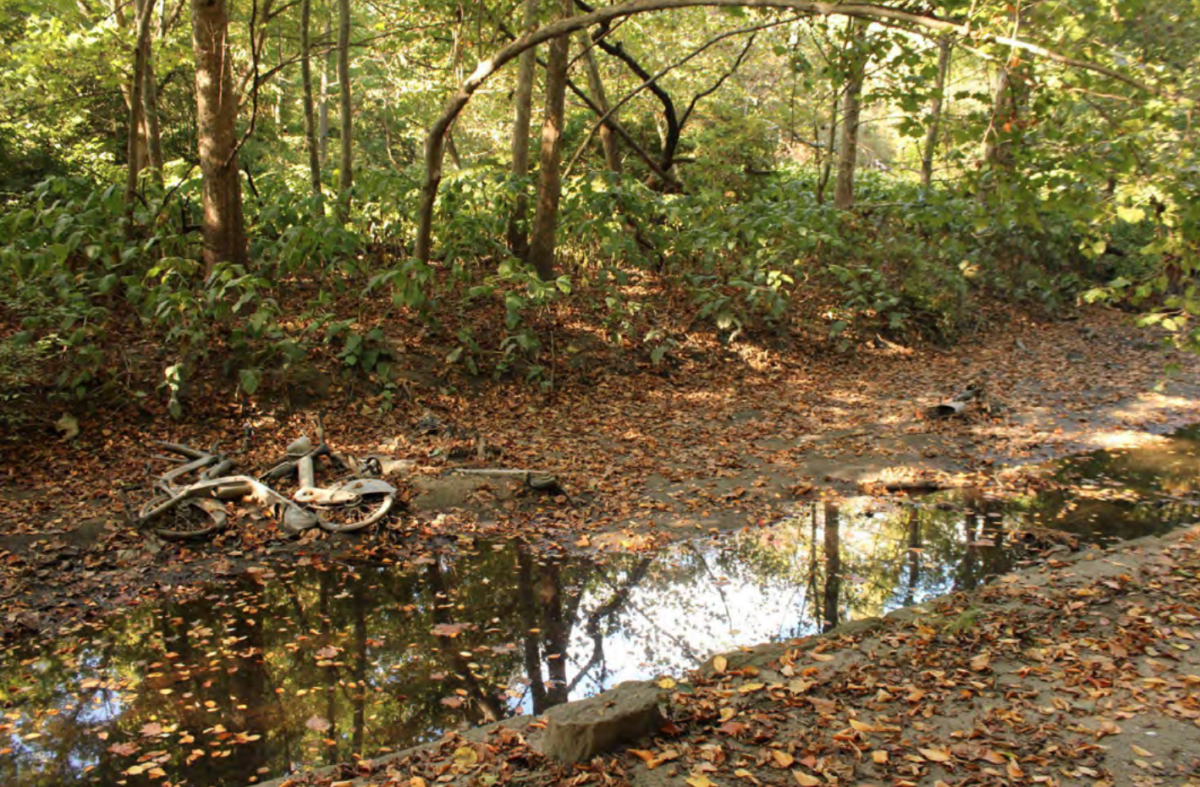
Artworks by students Maxanne Millerhaller, Nikki Phillips, Emily Torres, Olivia Griffin, Sofia Cordero, Guadalupe Vargas, Kelly Stanton, and Jonas Guzman.